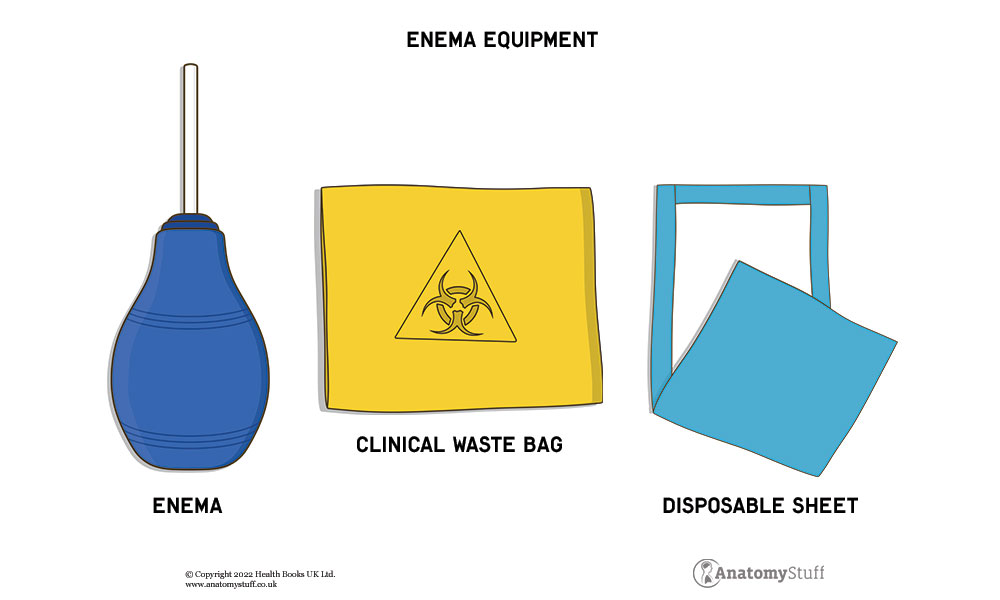Administration of an Enema
An enema is a liquid preparation that is administered via the rectum to move the bowels or give medication. As with all medication management, the administrator will first ensure the six rules of medication administration:
1. Right patient
2. Right medicine
3. Right time
4. Right route
5. Right dose
6. Right documentation
What types of enemas are there?
There are two types of enemas:
• Evacuant enemas are intended to prompt a bowel movement.
• Retention enemas are intended to be retained.
Why would you administer an enema – who needs an enema?
The most common reason an enema might be administered is constipation. Also used to clean out the bowel in preparation for a colonoscopy or other investigative procedure that requires a clear view of the bowel. Enemas can also be given for lower gastrointestinal X-rays such as barium X-rays.
What equipment will you need to administer the enema?
• Personal protective equipment (PPE) – apron and gloves
• Patient’s medication chart
• The enema and lubricating jelly with a jug of warm water
• Small clinical waste bag
• Disposable sheet
• Gauze swabs or tissues

Our Administration of an Enema Laminated Chart is a valuable tool for any nurse, professional or health student carrying out an enema administration.
How do you prepare for the administration of an enema?
It is crucial that the patient is comfortable and fully consents to every step of the procedure. Check patient identity and inform them exactly what is involved in administering an enema.
Consider the following before administration:
• Does the benefit of having the enema outweigh the risk?
• Enemas are invasive procedures; has the patient capacity to consent?
• Check that there are no contra-indications or precautions before administering enemas.
• Be aware of potential complications during the enema administration, such as perforation, haemorrhage, allergic reaction, etc.
• Assess renal function because administering a phosphate enema in an elderly patient with poor renal function may induce hyperphosphataemia.
• Patients with spinal cord injury can be susceptible to autonomic dysreflexia, a sudden and dangerous rise in blood pressure.
• Carry out a risk assessment as per your care setting policy.
• Ensure the enema is prescribed, check the patient’s identity, and gain informed consent.
• Enemas should be administered in a safe, effective and patient-centred manner.
Free PDF Downloads
View AllHow do you administer an enema?
• Explain the procedure to the patient and allow for questions.
• Ensure privacy and respect. Close bed screens and make sure no one enters during the procedure.
• Ask the patient to position themselves in a left lateral position with their knees flexed.
• Put an absorbent sheet/pad under the patient.
• Make sure the patient is comfortable.
• Place the enema in a jug of warm water for several minutes until it reaches around room temperature for the patient’s comfort.
• Wash your hands and put PPE and gloves on.
• Observe the perineal and perianal areas for abnormalities (haemorrhoids, wounds, lesions, gaping anus, etc.)
• Carry out a digital rectal exam with informed consent to assess the rectum. Insert a lubricated index finger, gently carry out the examination, note any abnormalities, wash hands and document the findings in the patient records. Use new gloves for the enema administration.
• Lubricate the enema nozzle and expel any excess air.
• Part the buttocks and gently insert the nozzle into the anal canal.
• Slowly squeeze the enema until all the contents are used.
• While still squeezing—which helps avoid re-entry of contents due to the vacuum effect in the enema—gently withdraw the nozzle.
• Check that the patient agrees to continue—there may be discomfort but not pain; if there’s pain, withdraw and reassure the patient.
• Advise the patient to retain the enema for at least 15 minutes.
• Ensure you communicate with the patient clearly, so they understand what to do. Make sure their respect and dignity are maintained.
• Ensure easy access to a toilet facility.
• Dispose of the equipment safely as per setting policy.
• Wash your hands.
• Document the procedure in the patient medical notes.
Remember, enema administration is invasive and can be embarrassing for some patients. Always protect the patient’s dignity and privacy, and practice in their best interests.
What are the potential risks of enema administration?
Generally, enemas, if administered correctly, are considered safe. However, there can be rectal irritation, rectal bleeding, perforation, and embolism are rare but need to be considered all the same.
Conclusion
As most enemas are given to help bowel movement from constipation, advise patients to eat a high fibre diet and drink at least eight glasses of water daily, along with regular exercise. These lifestyle changes should help keep bowel movements regular and prevent constipation.
Related products
View All













